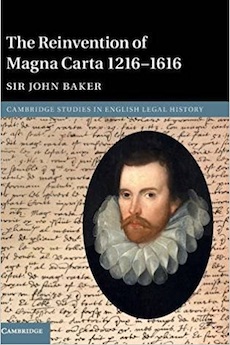By Allen D. Boyer
Marshaling a career’s worth of scholarship, drawing on an unmatched knowledge of the early modern common law, Sir John Baker has brought into bright focus a crucial moment in the life of Magna Carta: the Elizabethan moment when a truly constitutional resonance first sounded in the language of the Great Charter.
The passage in question was chapter 29.
“No free person (Nullus liber homo) shall be taken or imprisoned, or disseised of any free tenement or of his liberties or free customs, or outlawed, or exiled, or in any way destroyed, nor shall we go against him or send against him, except by the lawful judgment of his peers (per legale judicium parium suorum) or by the law of the land (vel per legem terrae); to no one will we sell, to no one deny or delay, right or justice.”
Signed by King John in June 1215, as a peace treaty, the Great Charter was repudiated by John a few weeks later; resurrected in 1216, as a charter issued by William the Marshal, acting as regent; reconfirmed by Henry III in 1225; and transformed from a grant of liberties to a statute in 1267. Throughout the medieval period, Magna Carta was venerated as paramount, fundamental law, but it hardly figured in the Year Books. At the Inns of Court, it was primarily a text from which legal analysis could be taught. (If the Charter opened with Concessimus Deo, did that mean that a grant could be made to God?) “Magna Carta was just another statute, and a largely obsolete one at that,” Baker comments.
The Charter’s revival began in 1581. Robert Snagge, a barrister of the Middle Temple, gave a reading (a series of lectures) on Magna Carta. In 1587, Snagge followed through by presenting to Lord Chancellor Sir Christopher Hatton a discussion on what was meant by “the law of the land.” Snagge was a Puritan gadfly, and his reading of per legem terrae appealed to Puritans who thought that their war against the Anglican establishment could be won in the courts.
Puritan dissidents feared the High Commission for Ecclesiastical Causes, the bishops’ sharpest weapon. However, the High Commission’s powers were not defined in the statute that created it – and thus Magna Carta could be cited to support claims that the High Commission was not acting pursuant to the law of the land. Likewise, Baker notes, “might not the phrase ‘disseised of his liberties’ extend to religious liberty? A lawyer who understood seisin in a legal sense would have been brave to suggest such a thing, but reinterpretation was now in the air.”
Snagge’s arguments poked up the fire. “After three centuries of virtual absence from the law reports, there were eight reported cases in 1587-88 in which chapter 29 was cited in the courts,” Baker writes. “It had a distinct emboldening effect on the judges and a catalytic effect on legal development.”
As early as 1604, years before he reached the bench, Sir Edward Coke had penned a personal memorandum on the scope of chapter 29. This clause, Coke asserted, defended “everything that anyone has in this world, or that concerns the freedom and liberty of his body or his freehold, or the benefit of the law to which he is inheritable, or his native country in which he was born, or the preservation of his reputation or goods, or his life, blood and posterity.”
Coke relied on chapter 29 in numberless arguments and rulings. His career linked Magna Carta to other fundamental doctrines and practices that undergird constitutional law. Coke emphasized that more than thirty Parliaments had confirmed the Great Charter, which connected the idea of liberty with parliamentary democracy. His stiff-backed character as a judge connected Magna Carta to the rule of law and the ideal of judicial independence.
Coke was removed from the bench in 1616. Yet even as his fall was being orchestrated, the constitutional learning for which he had been a fierce prophet was being reiterated. Francis Ashley offered a reading on chapter 29 that was as sweeping as anything Coke might have written. Less than forty years after Snagge’s reading, Baker concludes, “the scope of chapter 29 . . . had become almost limitless.” Modern ideas of human rights expand only slightly the various forms of liberty associated with Magna Carta:
“Already by 1616 those liberties had included, for all men or women, freedom from slavery or arbitrary arrest, detention, or exile; freedom from cruel or inhuman treatment; recognition as a person before the courts, with judicial remedies for any infringement of rights; a presumption of innocence until proved guilty according to law at a public trial, after an opportunity to be heard in one’s defense: freedom from arbitrary confiscation of property; protection of one’s good name; freedom of thought and conscience; and freedom from restraints in one’s employment. These liberties . . . might well have developed within the common law even if there had been no Magna Carta. But they were all gathered under the wing of its protection, and thereby acquired a special sanctity.”
The same year may mark both an anniversary and a new beginning. The year 2016 saw Britons vote to be governed by British institutions, and not from the Continent. Out of the old fields must come the new corn, Coke instructed those who bear responsibility for the law: what we have to work with must eternally be reworked, what we want to do must necessarily cohere with what we have done. With British law challenged to draw upon its own resources, Magna Carta may provide venerable, capacious, and sufficient authority.
Allen D. Boyer (ΦBK, Vanderbilt University, 1977), a lawyer and writer in New York City, is the author of “Sir Edward Coke and the Elizabethan Age.” Vanderbilt University is home to the Alpha of Tennessee Chapter of Phi Beta Kappa.




